Peptide therapies like Sermorelin can effectively boost your growth hormone production. By mimicking growth hormone-releasing hormone (GHRH), Sermorelin stimulates your pituitary gland to release growth hormone more naturally. This leads to benefits such as improved muscle growth, enhanced metabolism, and better sleep quality. While it's essential to monitor dosage and potential side effects, the clinical applications show promise. Discover how this approach may suit your health goals and the latest research in peptide therapies.
Key Takeaways
- Sermorelin stimulates the pituitary gland to enhance natural growth hormone release, mimicking growth hormone-releasing hormone (GHRH).
- Peptides like Tesamorelin and Ipamorelin specifically target fat reduction and minimize hormonal disruptions, aiding growth hormone levels.
- Administering peptides via subcutaneous injections optimizes absorption and effectiveness for boosting growth hormone in adults and children.
- Regular high-intensity exercise and amino acid supplementation can significantly amplify the effects of peptide therapies on growth hormone secretion.
- Clinical studies indicate marked improvements in growth rates and hormone levels with peptide therapies, while personalized dosing ensures optimal safety and results.
Overview of Sermorelin
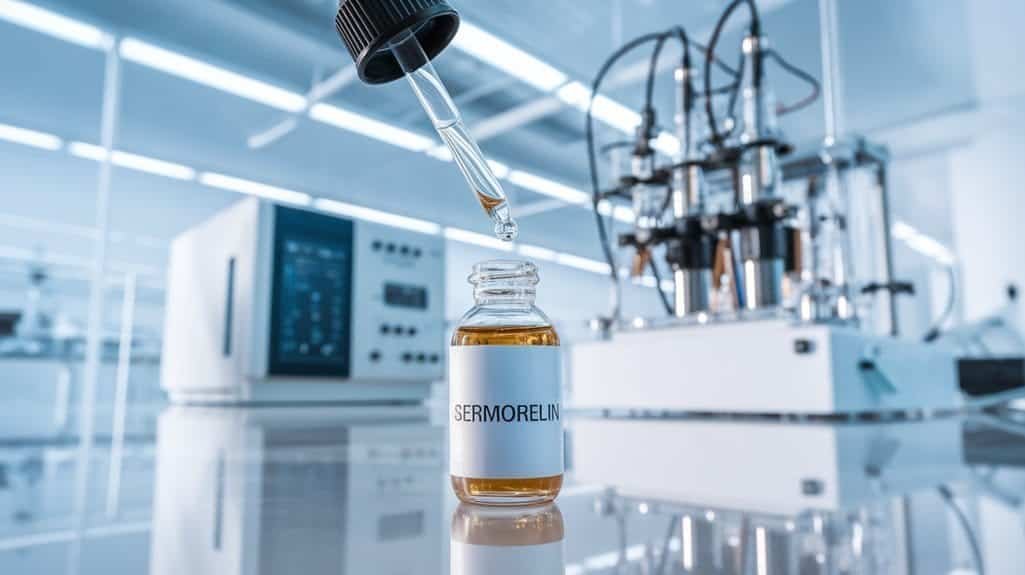
Sermorelin is a synthetic peptide that mimics the body's natural growth hormone-releasing hormone (GHRH), specifically the first 29 amino acids of the GHRH molecule, to stimulate endogenous growth hormone production.
Initially approved for treating children with growth hormone deficiencies, Sermorelin's therapeutic uses have expanded off-label for adult patients seeking to enhance their growth hormone levels. Studies have indicated that synthetic peptides like Sermorelin may vary in effectiveness depending on individual patient responses.
Known by trade names such as Geref and Gerel, it's typically administered via subcutaneous injection.
The peptide not only promotes muscle growth and energy levels but also aids in improving body composition, sleep quality, and cognitive function. Additionally, it supports overall health and well-being, making it an appealing option for those pursuing anti-aging therapies. Research continues to highlight the key physiological impacts of Sermorelin therapy, such as its effects on bone health and metabolism.
Since its FDA approval, ongoing research continues to explore its efficacy in various contexts, making it an intriguing option in hormone therapy.
Mechanism of Action in Growth Hormone Secretion
When you activate GHS receptors with synthetic peptides like GHRPs, you enhance growth hormone secretion from the pituitary gland.
This action not only boosts GH output but also modulates hypothalamic regulation mechanisms that balance GHRH and somatostatin release.
Understanding these processes helps you appreciate how peptide therapies can effectively stimulate growth hormone levels in various clinical applications.
GHS Receptor Activation
The activation of GHS receptors (GHS-R) plays an essential role in stimulating growth hormone (GH) secretion from the anterior pituitary gland. Upon ghrelin binding to the GHS-R1a, a G protein-coupled receptor, you initiate ghs receptor signaling pathways, including MAPK and PKA, leading to increased GH release.
While the GHS-R1a facilitates GH secretion, the GHS receptor structure reveals two variants, with the functional 1a being critical for this action. Importantly, the interaction with the endogenous GHRH system optimizes the GH response.
This complex regulatory mechanism underscores the significance of GHS-R activation in growth, energy balance, and metabolism, enhancing your understanding of its physiological implications.
Hypothalamic Regulation Mechanisms
Understanding the hypothalamic regulation of growth hormone (GH) secretion involves recognizing the intricate balance between stimulatory and inhibitory signals orchestrated by key peptides. GHRH modulation stimulates GH release, while somatostatin interaction inhibits it, ensuring homeostasis.
Neurotransmitter influence, particularly noradrenergic and cholinergic input, critically impacts both peptides' secretion. Ghrelin signaling serves as a potent activator of GH release, functioning as a functional antagonist to somatostatin during hormonal feedback. This peptide interplay integrates energy balance and nutritional status with GH secretion, reflecting the complex signaling environment.
Furthermore, essential pathways, including AMPK involvement, highlight the extensive regulatory network influencing hypothalamic control. These mechanisms are pivotal in designing therapeutic strategies targeting GH dysregulation through peptide therapies.
Benefits of Natural Growth Hormone Release
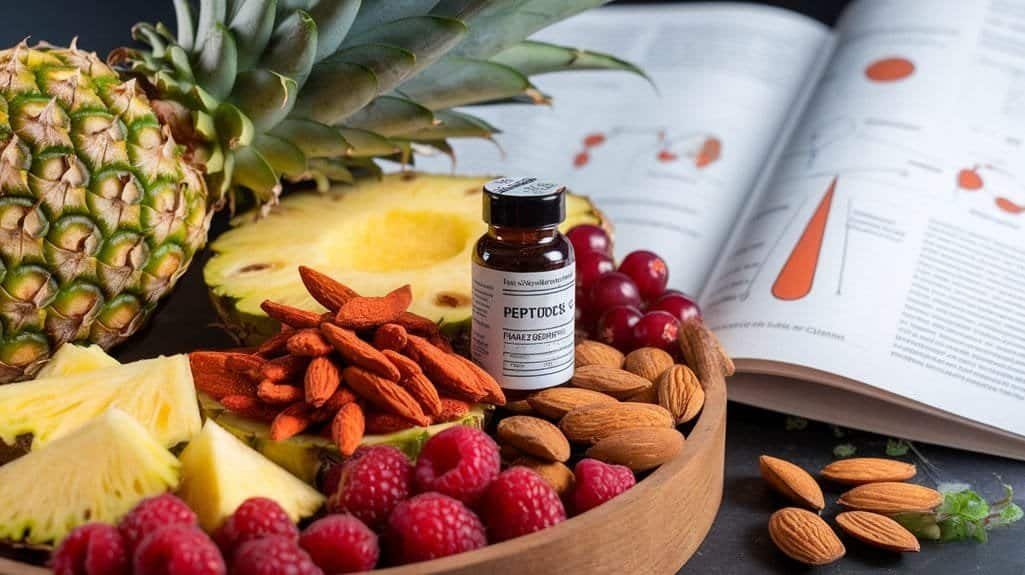
Natural growth hormone release considerably enhances muscle growth and improves metabolic health.
By promoting muscle mass development, it supports overall physical performance and strength.
Additionally, ideal levels of HGH facilitate better metabolic processes, contributing to weight management and overall health.
Enhanced Muscle Growth
While your body produces growth hormone (GH) naturally, maximizing its benefits can considerably enhance muscle growth and recovery.
Utilizing peptide therapies can lead to significant improvements in your strength training outcomes.
Here are key ways GH supports muscle development:
- Promotes muscle protein synthesis via increased IGF-I levels.
- Reduces muscle soreness and inflammation for faster muscle recovery.
- Stimulates collagen production, aiding in muscle and tendon repair.
- Improves lower body strength in healthy individuals through GH therapy.
- Enhances oxygen uptake and overall exercise capacity.
Improved Metabolic Health
As you prioritize metabolic health, harnessing the benefits of growth hormone (GH) release becomes essential.
Natural GH release supports metabolic improvements by enhancing fat metabolism through processes like lipolysis and fatty acid oxidation. Utilizing peptide therapies can effectively maximize hormone levels, facilitating fat loss while preserving lean muscle mass.
Additionally, incorporating amino acid supplementation can further boost GH production, amplifying these effects. A low-sugar diet combined with regular high-intensity exercise considerably increases GH levels, promoting better body composition and overall metabolic function.
Administration Methods and Dosage Considerations
Choosing the right administration method and dosage for peptide therapies is essential for maximizing growth hormone stimulation. Here are the key factors to evaluate:
- Injection Techniques: Subcutaneous and intramuscular methods guarantee efficient absorption.
- Nasal Sprays: Promote rapid distribution through mucous membranes.
- Oral Tablets: Offer potential routes but have lower bioavailability.
- Topical Creams: Best for localized effects like skin rejuvenation.
- Personalized Dosing: Range typically varies from 100 mcg to 300 mcg per injection based on individual needs.
Tailor your regimen taking into account your specific health goals, response, and regimen cycling of 8-12 weeks.
Starting with a lower dose can help gauge your tolerance and effectiveness with different peptide types. Always consult with a healthcare professional for best outcomes.
Potential Side Effects and Safety Profile
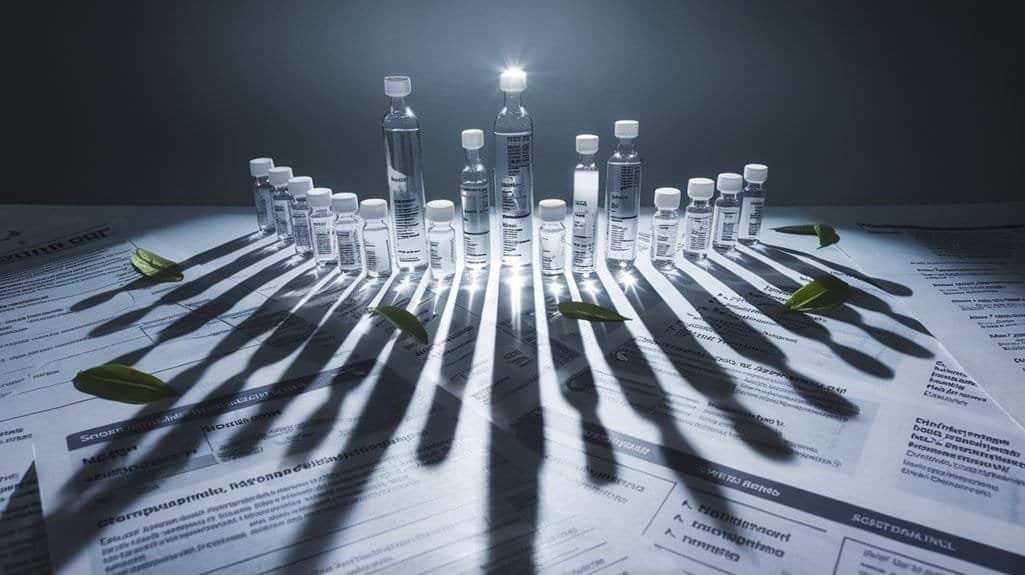
Understanding potential side effects and the overall safety profile of peptide therapies is essential for anyone considering their use.
A side effects overview reveals possible allergic reactions, including hives and difficulty breathing. Cardiovascular risks like high blood pressure and palpitations require caution, particularly with specific peptides that influence heart function. Hormonal imbalances, stomach issues, and cognitive side effects such as headaches can also occur.
Common injection site reactions and peripheral edema complicate matters. Safety considerations include consulting healthcare providers, especially for those with pre-existing conditions or those who are pregnant.
Given the limited FDA oversight and potential medication interactions, ensuring professional administration and monitoring is vital to minimize risks and optimize therapeutic outcomes.
Comparison With Other Growth Hormone Peptides
When exploring growth hormone peptides, it's vital to recognize the distinct mechanisms and specific applications of each option available. Understanding these differences allows you to optimize peptide stacking for hormonal balance.
Here's a quick comparison:
- Sermorelin: Modulates natural GHRH activity, maintaining GH rhythms.
- Tesamorelin: Potently targets visceral fat reduction.
- Ipamorelin: Specifically activates ghrelin receptors, minimizing hormonal disruptions.
- Hexarelin: Facilitates strong GH release, but may impact other hormone levels.
- Combined Use: Stacking these peptides can enhance metabolic effects and recovery, tailoring your approach based on desired outcomes.
Each offers unique advantages, making it important to assess your goals to choose effectively.
Clinical Applications of Sermorelin
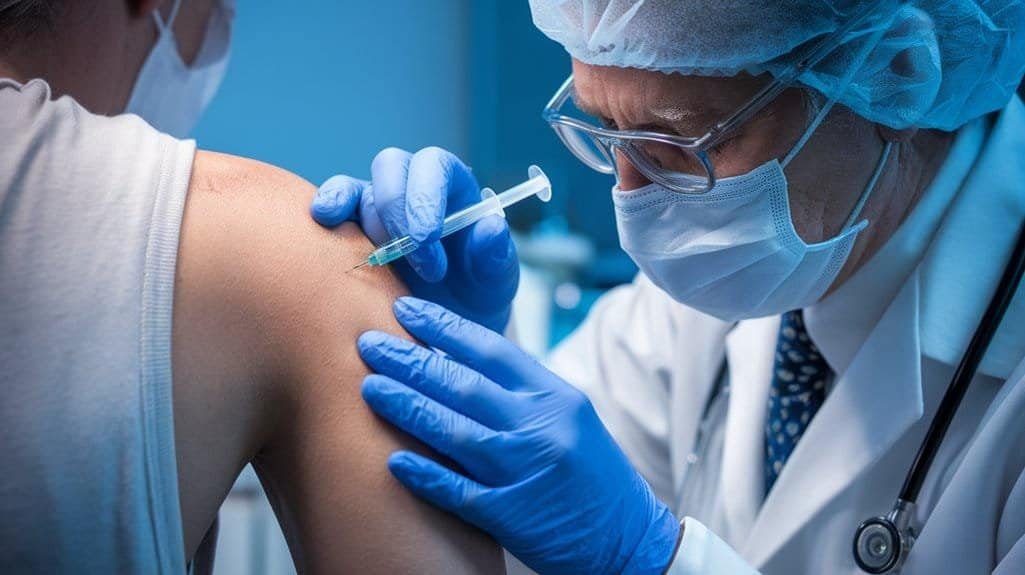
Sermorelin plays a pivotal role in treating growth hormone deficiency, particularly in pediatric patients, by stimulating the pituitary gland to release more growth hormone.
Additionally, emerging research examines its potential for age-related hormone restoration, sparking interest in its use among adults.
Clinical efficacy studies are essential for evaluating its benefits and optimizing treatment protocols for various conditions.
Growth Hormone Deficiency Treatment
Growth hormone deficiency can greatly impact development in children, but therapies like sermorelin offer a way to stimulate natural growth hormone production effectively.
When considering sermorelin for treatment, keep these key points in mind:
- Mechanism: It binds to GHRH receptors, promoting endogenous growth hormone release.
- Diagnostic Testing: Acts as a provocative test to accurately diagnose growth hormone deficiency.
- Catch-Up Growth: Many children experience significant improvements in growth rates.
- Safety Considerations: Generally well-tolerated; be aware of potential transient effects and drug interactions.
- Off-Label Use: Though primarily for children, some adults explore its benefits for increasing natural hormone levels.
Understanding these aspects helps optimize therapeutic outcomes while ensuring patient safety.
Age-Related Hormone Restoration
As the body ages, natural growth hormone levels decline, leading to various physiological changes that can affect well-being and vigor.
Sermorelin serves as an effective method for age-related hormone restoration by stimulating the pituitary gland to produce growth hormone naturally. This approach aligns with your body's circadian rhythm, promoting ideal hormone levels without requiring synthetic interventions.
By preserving pituitary function, it enhances neuroendocrine health, contributing positively to liveliness, skin quality, and sleep patterns.
Clinical applications of Sermorelin for aging adults reveal improvements in lean muscle mass and a reduction in body fat, which can greatly enhance overall body composition.
Furthermore, its convenient administration and safety profile make Sermorelin a compelling choice for countering age-related decline.
Clinical Efficacy Studies
Research supports the clinical efficacy of Sermorelin, particularly in managing growth hormone deficiencies across different age groups. This peptide therapy shows promise in clinical trial advancements, demonstrating significant benefits, such as:
- Stimulation of natural growth hormone production.
- Enhanced growth rates in 74% of children after six months.
- Improved hormone levels in adults with growth hormone deficiency.
- Favorable comparisons to traditional hGH due to fewer side effects.
- Positive impacts on body composition and bone density.
Sermorelin's potency as a diagnostic tool further underscores its importance.
While initial response times appear rapid, the full efficacy typically materializes after three to six months, highlighting the need for individualized dosage and careful monitoring in clinical practice.
Research Insights and Efficacy Studies
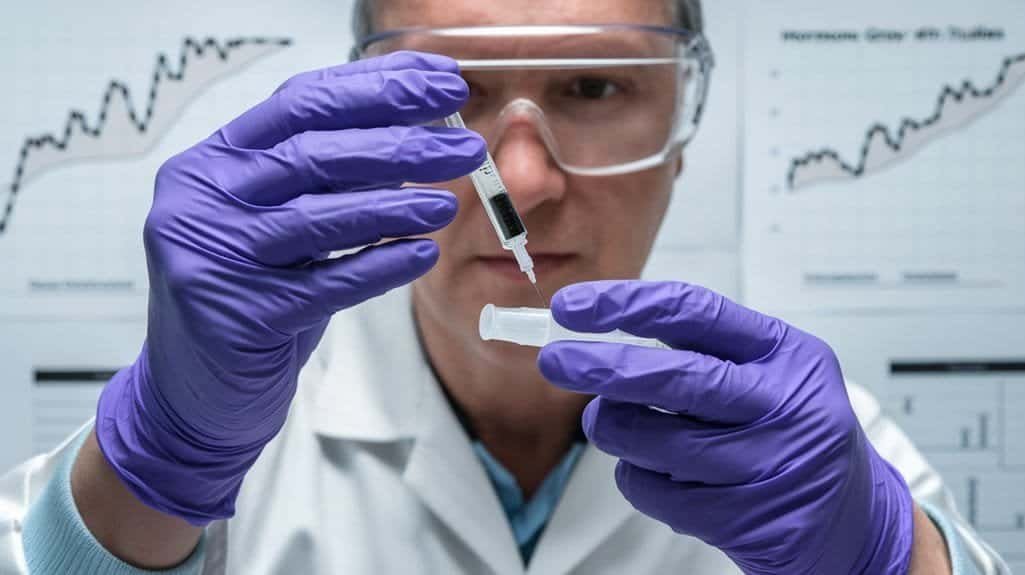
While many treatments aim to enhance growth hormone levels, peptide therapies, particularly growth hormone-releasing peptides (GHRPs), are gaining traction for their efficacy and targeted mechanisms.
Research indicates that peptides such as Sermorelin, Ipamorelin, and CJC1295 greatly boost human growth hormone production, making them highly effective, especially in hyposecretory conditions.
Clinical studies demonstrate these agents' ability to create therapeutic synergies when combined with other treatments, enhancing overall efficacy.
Remarkably, GHRPs provide a cost-effective alternative to direct human growth hormone injections and remain effective even in older populations, albeit with varying responses.
The engagement of specific receptors and the modulation of somatostatin activity underpin the success of these peptide combinations in stimulating growth hormone release.
Patient Experiences and Success Stories
Many patients have reported transformative experiences with peptide therapies aimed at boosting growth hormone levels.
These patient testimonials and success highlights reveal notable improvements, including:
- Significant increases in energy levels and liveliness in daily activities.
- Enhanced muscle strength and athletic performance after workouts.
- Faster recovery times, supporting regular exercise regimens.
- Improved weight management, aiding body composition and boosting self-esteem.
- Better sexual health, including increased libido and emotional preparedness for intimacy.
Patients also noted improvements in skin quality, mental clarity, and overall health satisfaction.
These outcomes not only contribute to a more youthful appearance but also elevate quality of life, affirming the effectiveness of peptide therapies in enhancing growth hormone levels and overall well-being.
Future Directions in Peptide Therapy and Growth Hormone Research
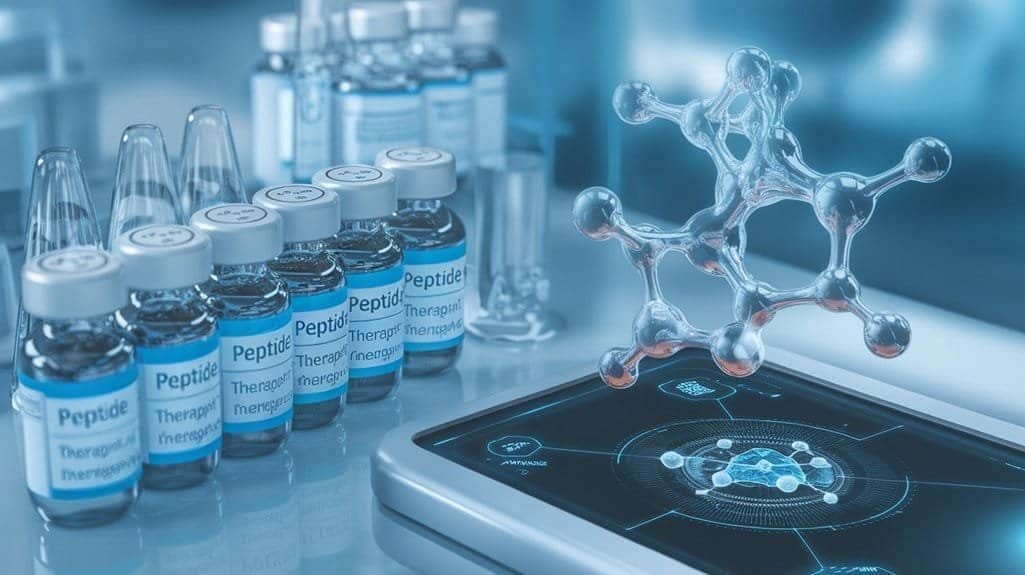
As advancements in peptide therapy continue to evolve, the future holds exciting possibilities for enhancing growth hormone research and its applications.
Multifunctional peptides are emerging as a promising area due to their ability to synergistically enhance therapeutic effects while minimizing side effects.
The exploration of cell-penetrating peptides (CPPs) could revolutionize drug delivery, allowing for direct cellular access and improving therapeutic outcomes.
Innovative delivery systems, including oral and transdermal methods, are also gaining traction, expanding accessibility to peptide therapies.
Additionally, PEGylation techniques are enhancing peptide stability and bioavailability, ensuring longer therapeutic action.
With high throughput screening technologies accelerating peptide discovery, the potential for novel growth hormone therapies and extensive treatment options continues to grow, shaping the future of peptide research.
Frequently Asked Questions
Can Peptide Therapies Improve Athletic Performance Significantly?
Yes, peptide therapies can greatly enhance athletic performance by improving recovery times and promoting muscle growth. Their mechanisms support faster tissue repair and reduced inflammation, ultimately leading to optimized overall athletic performance and resilience in training.
What Are the Long-Term Effects of Peptide Therapy?
Long-term effects of peptide therapy include potential risks like hormonal imbalances and organ damage, alongside long-term benefits such as enhanced recovery and increased energy. You must weigh these factors carefully before considering treatment.
Are There Age Restrictions for Using These Peptides?
There aren't strict age limitations for peptide use, but safety considerations vary with age. Starting in your late 20s or early 30s may enhance benefits, especially as growth hormone levels decline with age.
How Do I Choose the Right Peptide for My Needs?
To choose the right peptide, start by identifying your needs—whether it's muscle gain, fat loss, or anti-aging. Then, evaluate options based on safety, efficacy, and dosing requirements to achieve your specific health goals effectively.
Are Peptide Therapies Covered by Insurance?
About 70% of insurance policies don't cover peptide therapies, leaving you with significant coverage limits. For specific conditions like diabetes, some plans might apply, but you'll often incur substantial out-of-pocket costs for elective treatments.
Conclusion
To conclude, using Sermorelin for boosting growth hormone offers a promising pathway to enhanced liveliness and rejuvenation. By stimulating your body's natural hormone release, it's like opening a door to youthful energy and improved wellness. As research continues to unfold, the potential for peptide therapies to forge new frontiers in health is bright. If you're considering this innovative therapy, the journey toward revitalization could be just a consultation away. Embrace the possibilities and empower your growth!
References
- https://pmc.ncbi.nlm.nih.gov/articles/PMC5632578/
- https://www.admiremedical.com/blog/peptide1
- https://www.contemporaryhealthcenter.com/weightloss-peptide/growth-hormone-stimulating-peptide-therapy/
- https://www.health.harvard.edu/diseases-and-conditions/growth-hormone-athletic-performance-and-aging
- https://gamedaymenshealth.com/north-liberty/what-is-hgh-therapy-and-whos-a-candidate/
- https://gamedaymenshealth.com/franklin/sermorelin-peptide/
- https://www.rupahealth.com/post/sermorelin-peptide-guide-for-practitioners-and-patients
- https://en.wikipedia.org/wiki/Sermorelin
- https://pubmed.ncbi.nlm.nih.gov/18031173/
- https://gamedaymenshealth.com/san-diego/sermorelin-peptide/






